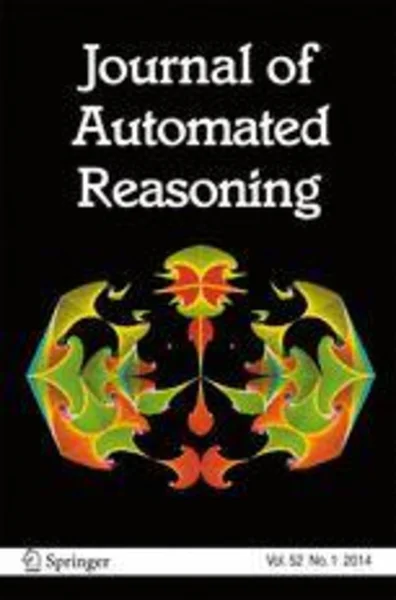-
a family of dynamic description logics for representing and reasoning about actions
جزئیات بیشتر مقاله- تاریخ ارائه: 1392/07/24
- تاریخ انتشار در تی پی بین: 1392/07/24
- تعداد بازدید: 1069
- تعداد پرسش و پاسخ ها: 0
- شماره تماس دبیرخانه رویداد: -
description logics provide powerful languages for representing and reasoning about knowledge of static application domains. the main strength of description logics is that they offer considerable expressive power going far beyond propositional logic, while reasoning is still decidable. there is a demand to bring the power and character of description logics into the description and reasoning of dynamic application domains which are characterized by actions. in this paper, based on a combination of the propositional dynamic logic pdl, a family of description logics and an action formalism constructed over description logics, we propose a family of dynamic description logicsddl(x @) for representing and reasoning about actions, where x represents well-studied description logics ranging from the to the
to the  , and x @ denotes the extension of x with the @ constructor. the representation power of ddl(x @) is reflected in four aspects. firstly, the static knowledge of application domains is represented as rboxes and acyclic tboxes of the description logic x. secondly, the states of the world and the pre-conditions of atomic actions are described by abox assertions of the description logic x @, and the post-conditions of atomic actions are described by primitive literals of x @. thirdly, starting with atomic actions and abox assertions of x@, complex actions are constructed with regular program constructors of pdl, so that various control structures on actions such as the “sequence”, “choice”, “any-order”, “iterate”, “if-then-else”, “repeat-while” and “repeat-until” can be represented. finally, both atomic actions and complex actions are used as modal operators for the construction of formulas, so that many properties on actions can be explicitly stated by formulas. a tableau-algorithm is provided for deciding the satisfiability of ddl(x @)-formulas; based on this algorithm, reasoning tasks such as the realizability, executability and projection of actions can be effectively carried out. as a result, ddl(x@) not only offers considerable expressive power going beyond many action formalisms which are propositional, but also provides decidable reasoning services for actions described by it.
, and x @ denotes the extension of x with the @ constructor. the representation power of ddl(x @) is reflected in four aspects. firstly, the static knowledge of application domains is represented as rboxes and acyclic tboxes of the description logic x. secondly, the states of the world and the pre-conditions of atomic actions are described by abox assertions of the description logic x @, and the post-conditions of atomic actions are described by primitive literals of x @. thirdly, starting with atomic actions and abox assertions of x@, complex actions are constructed with regular program constructors of pdl, so that various control structures on actions such as the “sequence”, “choice”, “any-order”, “iterate”, “if-then-else”, “repeat-while” and “repeat-until” can be represented. finally, both atomic actions and complex actions are used as modal operators for the construction of formulas, so that many properties on actions can be explicitly stated by formulas. a tableau-algorithm is provided for deciding the satisfiability of ddl(x @)-formulas; based on this algorithm, reasoning tasks such as the realizability, executability and projection of actions can be effectively carried out. as a result, ddl(x@) not only offers considerable expressive power going beyond many action formalisms which are propositional, but also provides decidable reasoning services for actions described by it.
مقالات جدیدترین رویدادها
-
استفاده از تحلیل اهمیت-عملکرد در ارائه الگوی مدیریت خلاقیت سازمانی و ارائه راهکار جهت بهبود
-
بررسی تاثیر ارزش وجوه نقد مازاد بر ساختار سرمایه شرکت های پذیرفته شده در بورس اوراق بهادار تهران
-
بررسی تأثیر سطح افشای ریسک بر قرارداد بدهی شرکت های پذیرفته شده در بورس اوراق بهادار تهران
-
بررسی تأثیر رتبه بندی اعتباری مبتنی بر مدل امتیاز بازار نوظهور بر نقد شوندگی سهام با تأکید بر خصوصی سازی شرکت ها
-
تأثیر آمیخته بازاریابی پوشاک ایرانی بر تصویر ذهنی مشتری پوشاک ایرانی (هاکوپیان)
-
الأدب الحدیث صدی الحیاه الاجتماعیه
-
آنالیز نیروهای ضربه ناشی از برخورد سازه های فولادی مجاور هم و نقش این نیروها در تشکیل مفاصل پلاستیک در اعضای سازه در هنگام زلزله
-
تاثیر میکروسیلیس بر مقاومت فشاری و روند رشد آن در ملات های سیمانی
-
بررسی اثربخشی درمان شناختی-رفتاری، مذهبی فرهنگی در بهبود مبتلایان به اختلال وسواسی- جبری
-
hydrogenation of succinic acid to tetrahydrofuran (thf) over rhenium catalyst supported on h2so4-treated mesoporous carbon
مقالات جدیدترین ژورنال ها
-
مدیریت و بررسی افسردگی دانش آموزان دختر مقطع متوسطه دوم در دروان کرونا در شهرستان دزفول
-
مدیریت و بررسی خرد سیاسی در اندیشه ی فردوسی در ادب ایران
-
واکاوی و مدیریت توصیفی قلمدان(جاکلیدی)ضریح در موزه آستان قدس رضوی
-
بررسی تاثیر خلاقیت، دانش و انگیزه کارکنان بر پیشنهادات نوآورانه کارکنان ( مورد مطالعه: هتل های 3 و 4 ستاره استان کرمان)
-
بررسی تاثیر کیفیت سیستم های اطلاعاتی بر تصمیم گیری موفق در شرکتهای تولیدی استان اصفهان (مورد مطالعه: مدیران شرکتهای تولیدی استان اصفهان)
-
بررسی آثار تلاوت قرآن کریم و شنیدن آوای آن بر ابعاد سلامت معنوی در دانشجویان دانشگاه پیام نور
-
مقایسه نیم رخ روانی دانش آموزان معتادی که بعدازترک مصرف مجدد داشته اند با دانش آموزانی که به یاری مشاوران مدرسه پاکی خود را حفظ کرده اند در شهر تهران
-
سبک ها در طراحی داخلی
-
surveying the causes of tendency of islamabad qarb youth to synthetic drugs and ways to prevent it
-
effects of fiber volume fraction and aspect ratio on mechanical properties of hybrid steel fiber reinforced concrete




سوال خود را در مورد این مقاله مطرح نمایید :